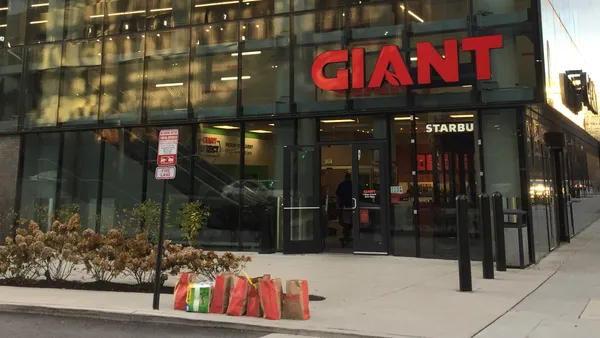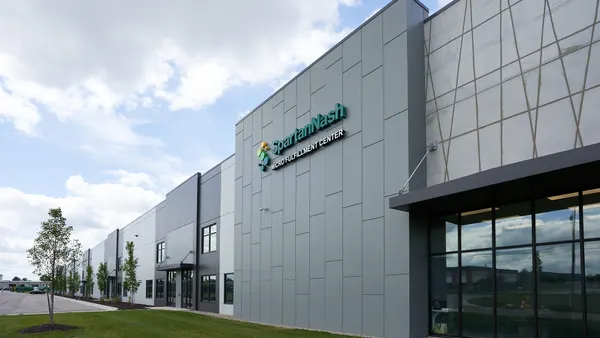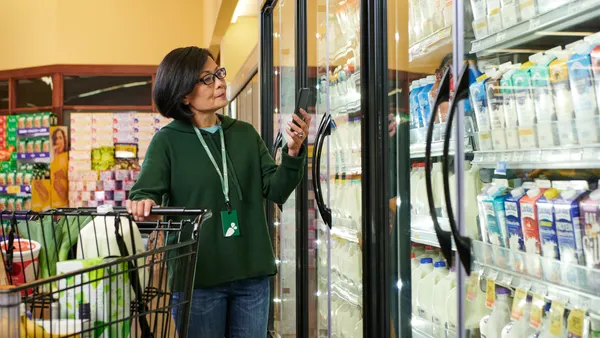To appeal to consumers' growing desire for transparency and to know where their food came from, retailers across the country have brought local products into their aisles. They've also created informational web pages, integrated with nutrition apps and encouraged suppliers to tell their story to customers.
With 95% of consumers saying they'll pay more for locally grown products and 21% saying they eat local at least twice a week, though, companies are feeling the pressure to up the ante. Some, like Kroger and Whole Foods, have taken that step by bringing high-tech produce farms into their aisles — a budding movement that's made possible by advancements in growing technology.
“Across the indoor farming industry, there have been dramatic decreases in cost when it comes to the physical hardware, advanced LED lighting and technology platforms automating a lot of the growth cycle,” Alexander Olesen, founder of automated mini-farm purveyor Babylon Micro-Farms, told Grocery Dive.
As more and more retailers discuss shifting center store operations online and accentuating the store perimeter, miniature produce farms promise to offer a supply line as well as a touch of food theater.
“We are also seeing a lot of traditional goods that grocers stock being purchased online and it’s freeing up a lot of space in-store,” Olesen said.
Retailers have been bringing cultivation to their stores for several years now. As early as 2012, Rouses sought to dazzle shoppers with an aeroponic garden on the rooftop of one of its New Orleans store locations. Hy-Vee and H-E-B's Central Market stores have also experimented with growing operations, with the latter adding a 53-foot modified shipping container full of greens to one of its Dallas stores.
Whole Foods has established a few different store growing operations. In 2018, it added an in-store mushroom growing display inside its Bridgewater, New Jersey store. The system was provided by Smallhold, a Brooklyn-based indoor farming company that also sells its mushrooms to local restaurants. A few years earlier, the chain partnered with urban greenhouse operator Gotham Greens to open a growing facility on top of a Brooklyn store location.
The trend has gained momentum in Europe and Japan. Founded in 2013, Berlin-based InFarm has placed its in-store farms, which grow leafy greens, herbs and vegetables, in hundreds of European stores, while Amazon Fresh sells its produce in Germany, France and Switzerland. Last year, the company raised $100 million in Series B funding.
InFarm recently made its U.S. debut with two Kroger-owned QFC stores in Seattle and will bring its sprigs of kale, mint, cilantro and dill to 13 more banner locations this year. The greens are initially planted at a nearby distribution center before being transferred to the store, where each plant's growth is monitored remotely by the company. The price points for the greens are competitive at $2.99 per bunch.
Grocery Dive reached out to Kroger and Whole Foods for comment but did not hear back by press time.
InFarm has lofty ambitions for its in-store farms, hoping to significantly impact grocery and restaurant supply chains, according to co-founder and CMO Osnat Michaeli.
“By growing produce on demand and as close to possible to where it’s consumed, retailers are able to reduce food waste and sunk costs typically linked to industrial farming,” Michaeli wrote in an email to Grocery Dive. “We find that when retailers are able to understand the value, quality and flexibility of our business model they are more than enthusiastic to enter into conversations to explore our farms.”
Retail attraction or real action?
Although in-store farm displays and gardens are attractive additions, farming is no small feat even at a micro-scale.
“I think this trend is going to be closer to food theater and closer to a niche that engages the public and excites them about fresh produce,” Neil Mattson, associate professor at Cornell’s School of Integrative Plant Science, told Grocery Dive. Through his research, Mattson specializes in controlled environment agriculture systems such as hydroponics.
Operating an in-store farm is not for the novice beginner, he adds, noting that a retailer or its farming partner will have to allocate employees to monitoring the in-store farm to ensure it’s working properly. This requires intensive training, adds labor hours and could take the employee away from other tasks that still need doing.
If an in-store farm is not operating properly, the plants could fall victim to unsightly mold, disease and other issues that would make the display unappetizing to shoppers. Should a situation like this arise, the plants must be stripped out immediately and all surfaces must be sanitized, leaving an empty display, said Mattson.
Even for high-tech farming systems that are remotely monitored, Mattson has concerns about long-term success.
"Plants are biological systems so sometimes they don’t grow as fast as you think they should or some other factor becomes limiting and you have to adjust," he explained.
Mattson also questions whether an in-store farm could supply enough produce to be more than just an interesting display for consumers. Produce sales in the U.S. totaled $60.8 billion during 2018, representing a 1.7% increase over the prior year. The input costs for indoor farming systems, namely water and around-the-clock electricity to power LED lights, are also substantial barriers even for large-scale indoor growing operations.
“It’s hard to foresee this producing the quantities of produce at the price points needed to become the widespread way that most Americans would buy their lettuce," Mattson said. "I think it is an expensive way to grow produce in a supermarket.”
High-tech farming operations have struggled to overcome high costs in the past, but the new crop of companies like InFarm and Babylon claim their systems are much more cost-effective and scalable.
To the extent that a retailer could overcome these challenges, benefits to having an in-store farm would include cutting out distributors and other middlemen, who often hike up the price of produce, and increasing store traffic, Mattson said. He believes the success of in-store farms may depend on balancing production needs and efficiency with the desire to amuse consumers.
Mattson said a larger-scale operation like Whole Foods' rooftop farm in Brooklyn offers the benefits of a customer draw with a more viable supply line. In recent years, retailers have also turned to large greenhouse and vertical farming operations to supply stores. Gotham Greens operates greenhouses in five states while BrightFarms operates greenhouses in four states and supplies to retailers like Giant Food, Acme and Food Lion.
Finding the middle ground
For Brooklyn-based grower and Whole Foods partner Smallhold, providing mushrooms first and in-store farms second has been a recipe for success. The duo behind the operation started out in a shipping container offering locally grown mushrooms to restaurants. They began asking their buyers whether they could fit a mini mushroom farm on-site and were encouraged enough to start modeling a prototype.
Whole Foods Local Forager Elly Truesdell ate lunch at a Vietnamese restaurant where one of Smallhold’s mushroom farms is located and promptly contacted the company to see about locating one at a Whole Foods store, according to co-founder Adam DeMartino.
“We didn’t intend to start a produce brand, it just sort of happened and a lot of that was because of Whole Foods,” DeMartino told Grocery Dive.
Today, Smallhold maintains mini mushroom farms in restaurants and retail locations, including two Whole Foods stores. It also sells mushrooms under a branded label.
Smallhold visits retail locations where its mini-farms are located once a week to swap out materials and harvest mushrooms. To achieve the volume that a retailer like Whole Foods demands, the company breaks up the growth process, completing the final stages, or fruiting, in-store. Mushrooms have an advantage over other crops grown indoors because of the high weight per square foot that mushrooms usually yield, according to DeMartino.
“Is it right for everyone? I’m not sure. That’s why it’s not the only thing we do,” co-founder Andrew Carter added. “How we look at it is we are offering a bunch of different tools to accomplish the task of getting mushrooms into the hands of everyone in the U.S. and hopefully the world. One of these tools is increasing the visibility of farming by growing on-site.”










